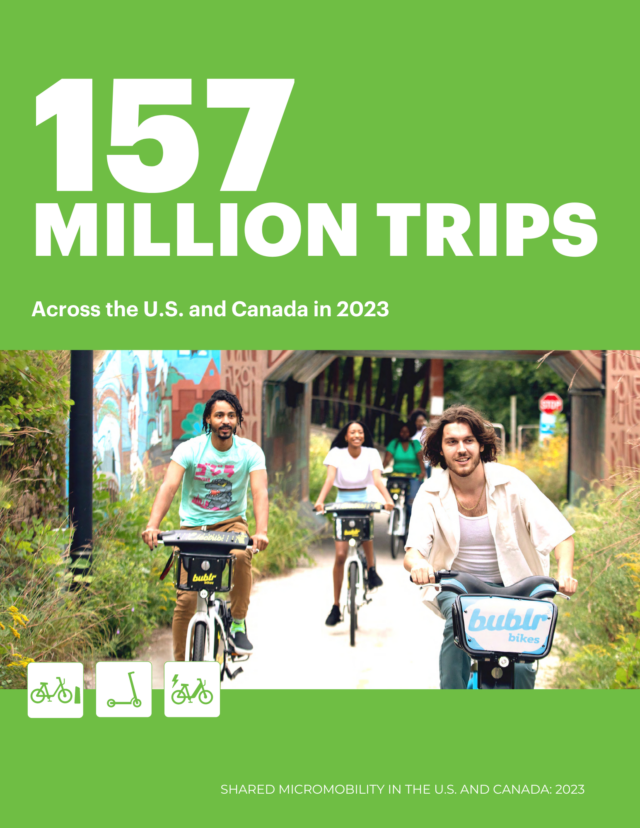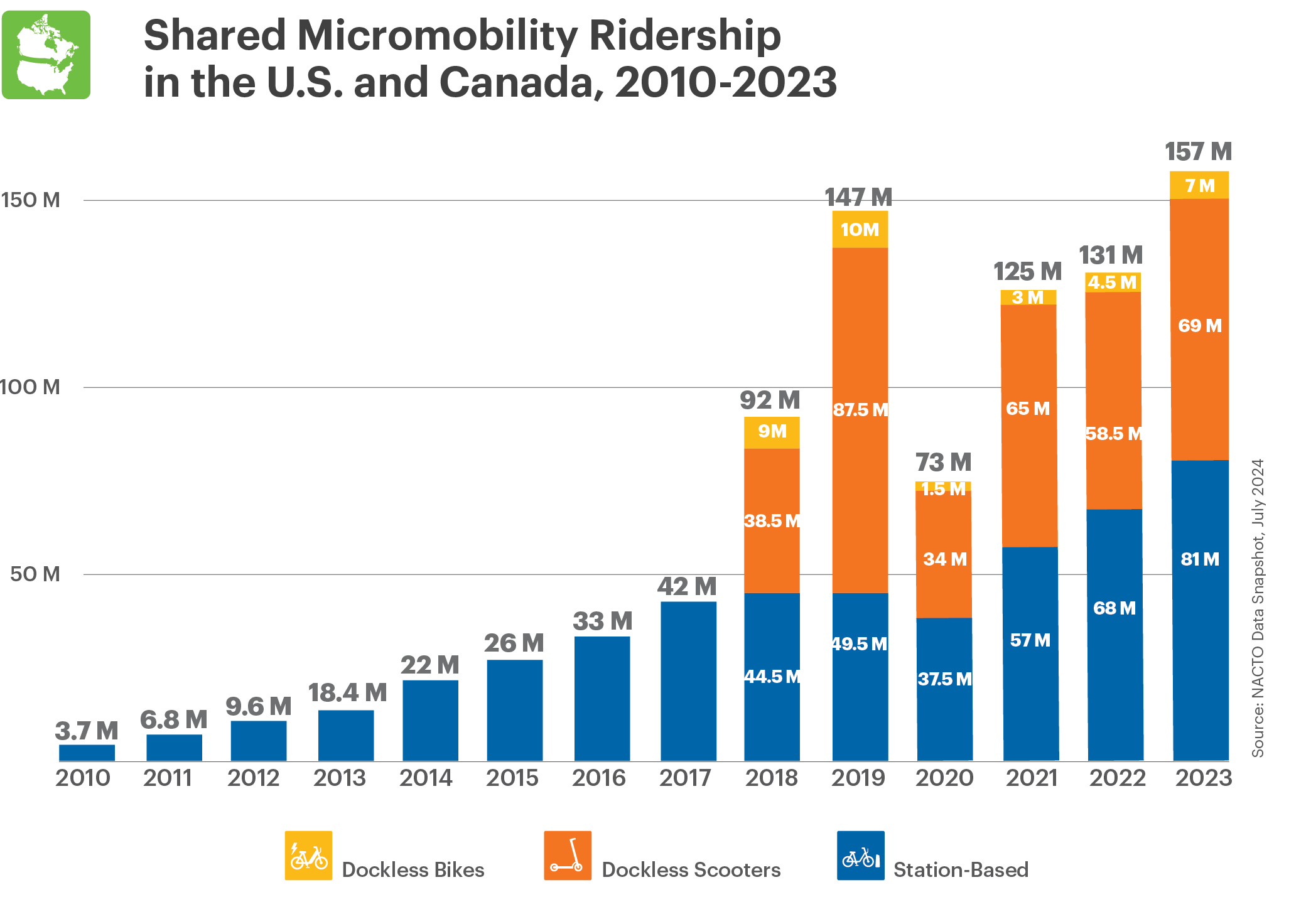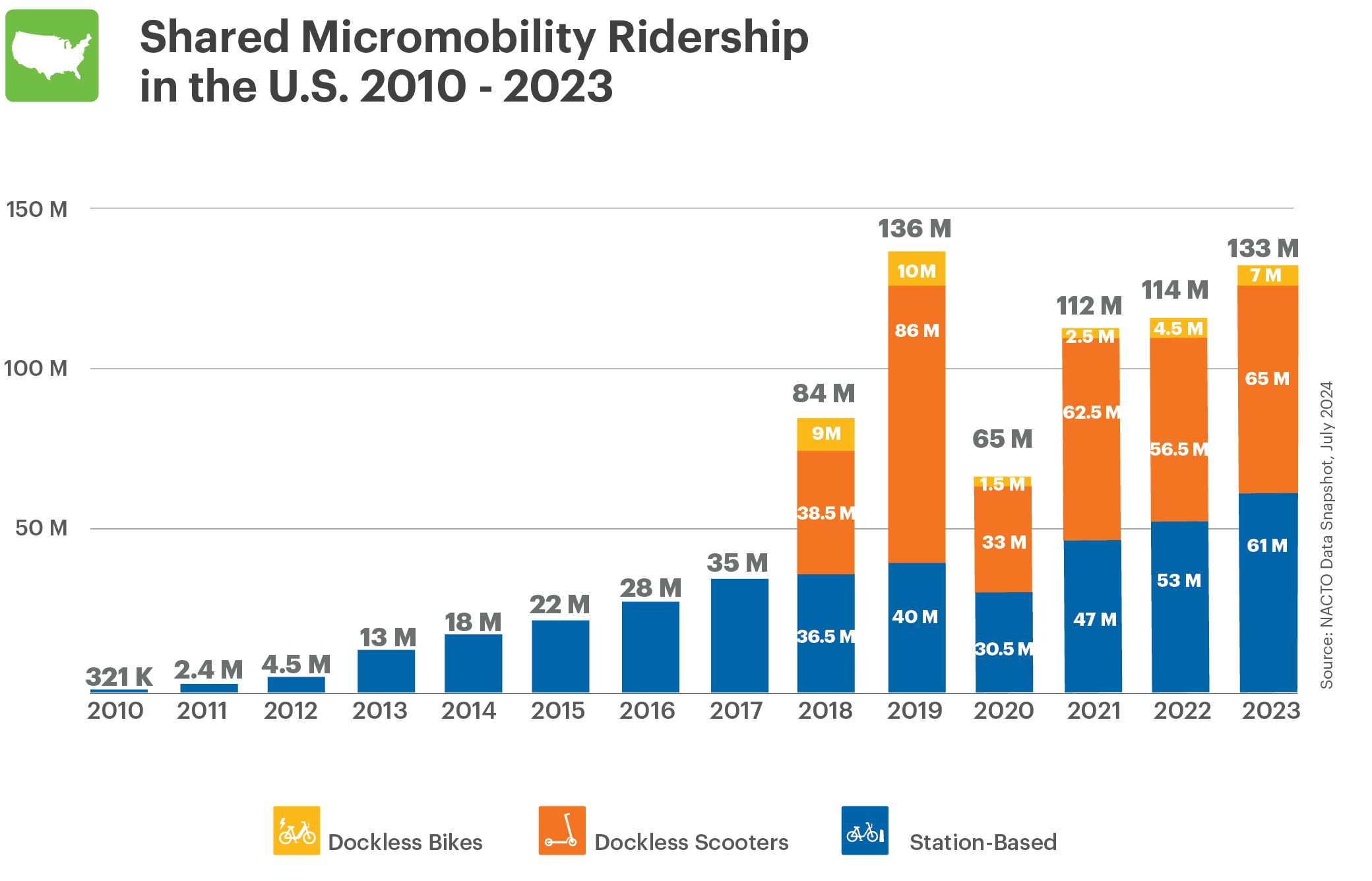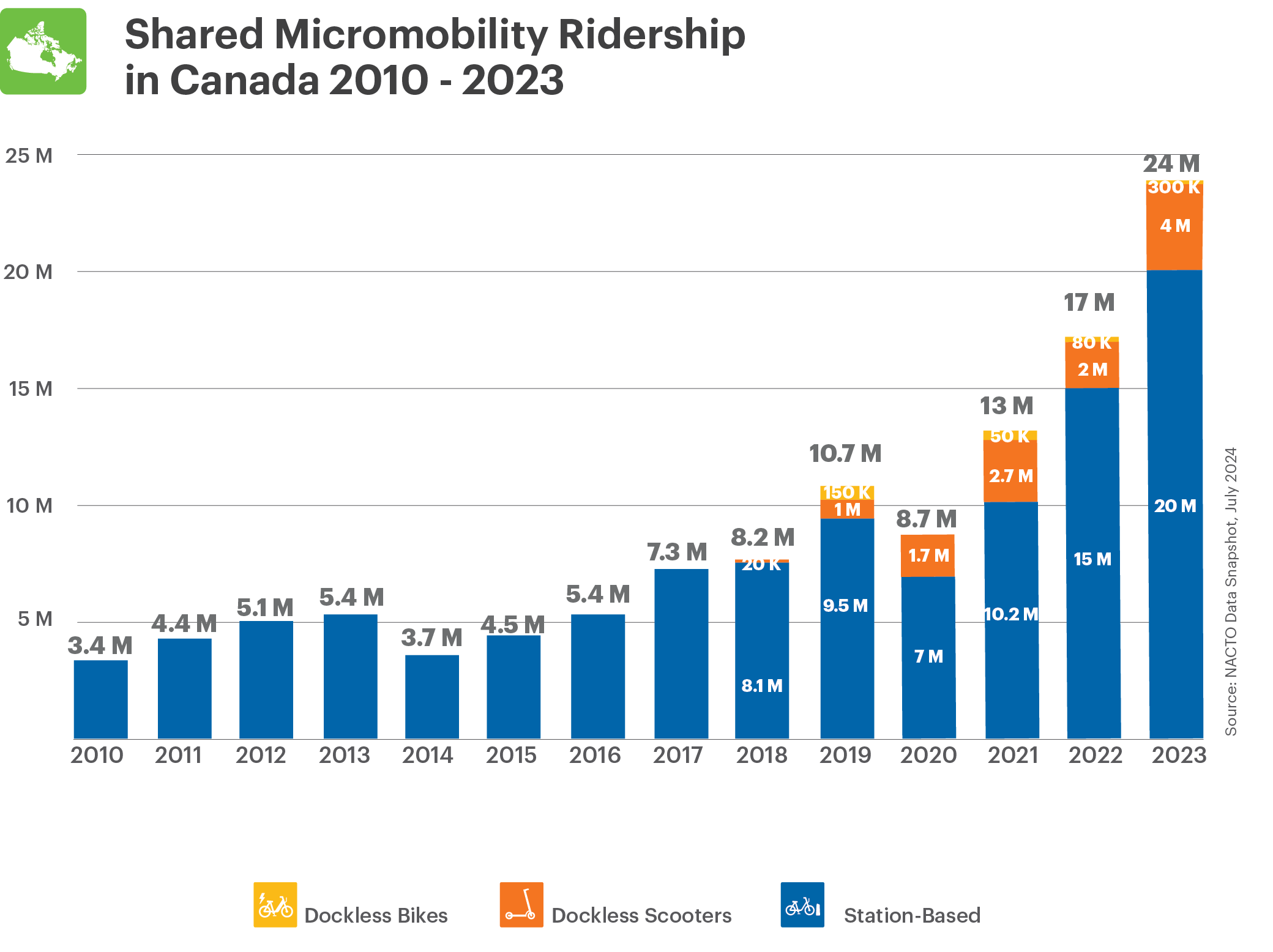A New Record: 157 Million Shared Micromobility Trips Were Taken in the U.S. and Canada in 2023
 In cities across the U.S. and Canada, shared micromobility is a popular and growing form of public transportation, often replacing short car trips and extending the reach of public transit.
In cities across the U.S. and Canada, shared micromobility is a popular and growing form of public transportation, often replacing short car trips and extending the reach of public transit.
NACTO’s 2023 Shared Micromobility in the U.S. and Canada report examines data on dockless bikes, dockless e-scooters, and station-based bike share systems in cities across North America, finding that trips on these systems reached an all-time high in 2023.
Despite the overwhelming popularity of these systems, many cities are grappling with the challenges of providing this essential service while facing limited financial and operational resources. A volatile private operator landscape coupled with increasing user costs threatens to limit the potential for shared micromobility to be affordable and accessible to all. Shared micromobility is at an inflection point; it is imperative that cities design durable operational models to ensure the long-term viability of this increasingly relied-on transportation mode.
Read the full report (pdf), read the press release, or check out some highlights below.
The Numbers
 In cities across the U.S. and Canada, shared micromobility is a popular and growing form of public transportation, often replacing short car trips and extending the reach of public transit. In just 13 years, people have taken 887 million trips on shared bikes and scooters in the U.S. and Canada.
In cities across the U.S. and Canada, shared micromobility is a popular and growing form of public transportation, often replacing short car trips and extending the reach of public transit. In just 13 years, people have taken 887 million trips on shared bikes and scooters in the U.S. and Canada.
Total trips on shared micromobility increased by 20% from 2022, surpassing the pre-pandemic 2019 peak of 147 million trips across both countries.
 People took 133 million trips on shared micromobility in the U.S. Trips in the U.S. increased by 16% in 2023, driven largely by the continued growth of e-bike trips on larger station-based systems.
People took 133 million trips on shared micromobility in the U.S. Trips in the U.S. increased by 16% in 2023, driven largely by the continued growth of e-bike trips on larger station-based systems.
 People took 24 million trips on shared micromobility in Canada. Shared micromobility trips in Canada increased by a whopping 40% in 2023, due to the continued expansions of station-based systems and the introduction of dockless e-scooters into new markets.
People took 24 million trips on shared micromobility in Canada. Shared micromobility trips in Canada increased by a whopping 40% in 2023, due to the continued expansions of station-based systems and the introduction of dockless e-scooters into new markets.
Station-Based Systems
Ridership growth on station-based systems jumped to 81 million trips in 2023 from 67 million trips in 2022.
Dockless Scooters
After a drop in trips in 2022, e-scooter systems began to bounce back in 2023 with a 15% increase in trips in the U.S. and Canada: 69 million in 2023 compared to 58.5 million in 2022.
Dockless E-Bikes
Despite representing the smallest group of shared micromobility devices, the use of dockless e-bikes has grown in the past year. In Canada, trips nearly quadrupled, from less than 100,000 in 2022 to 300,000 in 2023. In the U.S., people took 6.7 million trips on dockless e-bikes, a nearly 50% increase from 4.5 million trips in 2022.
Affordability is a Growing Challenge
Bike share prices are now significantly higher than other public transportation options, especially for those taking pay-as-you-go trips. On average, a trip costs around $3.00 for the first 30 minutes of riding. After that half-hour, users pay an additional $0.10 to $0.20 for each minute. If someone wants to use an e-bike, those additional fees, on average, add an extra $0.22 per minute. For a typical 30- to 35-minute pay-as-you-go trip on station-based bike share, this results in an average cost of $3.85 for a one-way pedal bike trip and $7.00 or more for a one-way trip on an e-bike. These costs quickly become unattractive for potential users, adding up to $14 per day for commuting.
E-scooters and dockless e-bikes are valuable shared micromobility options, especially in cities without station-based systems. However, the high user costs of these devices limit their longterm viability as an affordable choice. The typical trip length on a dockless e-bike and e-scooter is 11 to 12 minutes–much shorter than pay-as-you-go station-based bike share trips, which are 30 to 35 minutes on average. Despite the quick trips served by these modes, riders are paying a lot more per trip. The average cost of a one-way trip on a dockless e-bike or e-scooter was around $6.00 in 2023, with the most expensive trips ranging from $11 for a 15-minute trip in Arizona to nearly $9.00 for a six-minute trip in North Carolina. At these rates, e-scooters and e-bikes are not an affordable everyday option for most people.
Read the full report (pdf) for more numbers >
Public Funding Ensures Reliable, Affordable Service
Another unstable year in the industry demonstrates that it is more important than ever to secure sustainable funding models for shared micromobility programs. Bankruptcies and mass layoffs across multiple private operators continued to disrupt service in the U.S. In 2023, multiple cities lost their shared micromobility programs overnight. Further consolidation of large firms has led to inconsistent communications between cities and operators. Some cities are facing the challenge of “too much” success–their shared micromobility programs are wildly popular, but the demand for more devices and longer operating hours has outpaced program staff and budget capacities.
Cities with privately financed systems weren’t the only ones subject to service disruptions due to lack of financing. Decade-old station-based programs in Cincinnati, Houston, and Minneapolis faced shutdowns when their major sponsors pulled out in 2023, leaving programs without alternative sources of funding. The financial volatility for even heavily-used systems prompted a number of cities and agencies to shore up durable financing and subsidies for shared micromobility, through public funding, foundation support, and longer-term sponsorships.
Read the full report (pdf) for more >
Realizing the Potential of Shared Micromobility
Over the past decade, shared micromobility has firmly woven itself into the fabric of North American transportation networks. In cities across the U.S. and Canada, people of all ages and backgrounds are biking or scooting to work and school, to pick up groceries, or to spend quality time with friends, family, and community. When cities commit to making these systems affordable across incomes and build connected networks of protected bike lanes, they support the potential for even more ridership.
Read the full report (pdf) for more >
Looking Forward
The coming year will be an exciting one for shared micromobility, as cities across the U.S. and Canada celebrate one billion trips on shared bikes and scooters. The hard-won success of this transportation mode should not go unnoticed–shared micromobility has proven to be tremendously resilient in the face of early skepticism, major shakeups and disruptions, a global pandemic, and ongoing concerns about long-term viability.
The number of people using shared micromobility is at an all-time high, and can be attributed to the consistent and collaborative efforts of cities, operators, government agencies, and their community partners to get people on shared bikes and scooters, and ensure people have safe places to ride. However, shared micromobility continues to have an uncertain financing model in many cities, and is becoming increasingly unaffordable. Now is the moment to fully consider whether shared micromobility serves as public transportation, or primarily as a downtown economic development tool. For cities that wish to provide shared micromobility as a public service, a hard look at finances, subsidies, and affordability is necessary for this to continue to be an accessible transportation mode.
Recommendations
- Invest public money in shared micromobility capital and operating costs: consider public ownership of systems and public subsidies to make shared micromobility services more broadly affordable and reliable.
- Eliminate sales tax on shared micromobility: Riders on other forms of public transportation don’t have to pay sales tax–eliminate this added expense for users.
- Build the infrastructure to get people where they want to go, safely: support trips by building well-connected, protected bike lane networks and placing shared micromobility devices and stations close to homes and popular destinations.
Read the full report (pdf) >